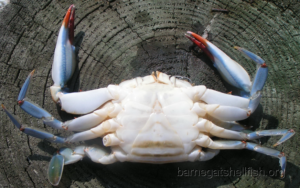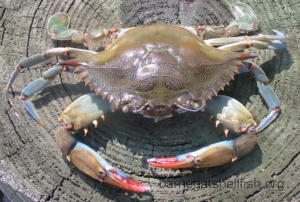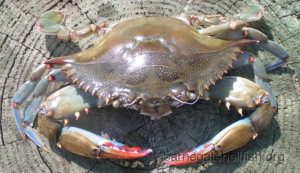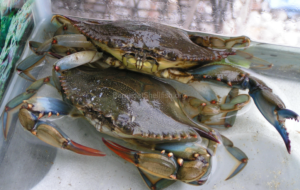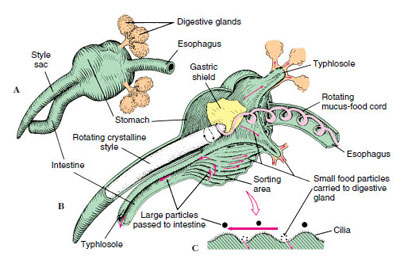
Barnegat Bay is home to several species of crabs, but the Blue crab is the most common and sought after.
Crabs Crustaceans
Crab Life Cycle
Blue crabs mate from May through October in the brackish waters of Barnegat Bay
Fun Fact – Blue crabs go by many names, but some of the most popular are “jimmy” for a male, “sook” for an adult female and “sally” or “she-crab” for an immature female.
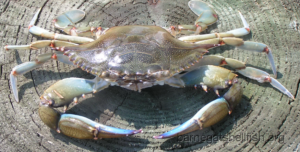 Jimmy
Jimmy
A male blue crabs (both adult and immature) is called a jimmy.
The tips of the claws are bluish in color and on the underside, the apron or abdomen is shaped like an inverted letter “T”.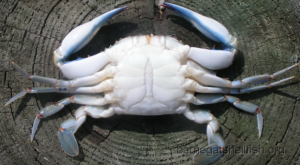 It is sometimes described as being in the shape of the Washington Monument.
It is sometimes described as being in the shape of the Washington Monument.
(click on image to enlarge)
Mating and Spawning
 The image to the right show a recently molted female cradled by a male and the empty exoskeleton (slough) in the foreground.
The image to the right show a recently molted female cradled by a male and the empty exoskeleton (slough) in the foreground.
She is now sexually mature. With the final molt her abdomen shape is changed from a “V” to a “dome”.
After molting, the female turns on her back and unfolds her abdomen.
The male then transfers his sperm in specialized packets called spermatophores to the female.
She stores these packets in specialized sacs called spermathecae.
From a single matting a sook can produce many fertilized egg masses during her lifetime.
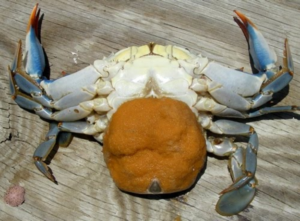 In 2 to 9 months, the female will spawn fertilize the eggs and will develop an external egg mass called a sponge on the underside of her abdomen which may contain between 750,000 and 8 million eggs. The average is about 2 million.
In 2 to 9 months, the female will spawn fertilize the eggs and will develop an external egg mass called a sponge on the underside of her abdomen which may contain between 750,000 and 8 million eggs. The average is about 2 million.
These crabs are referred to as “sponge crabs“. and hatching of the eggs occurs in approximately 2 weeks after the formation of the sponge.
Over the two weeks the sponge gradually turns from orange to brown and then black as the larval crabs develop inside the egg.
Growth
 Crabs starts life as a larva, an early-life stage that looks completely different than their adult form.
Crabs starts life as a larva, an early-life stage that looks completely different than their adult form.
Not looking much like crabs they spend 30 – 50 days going through seven larval stages called zoea.
Even though microscopic, the larvae have an exoskeleton and need to molt.
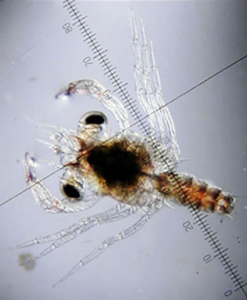 After the last zoeal stage, the crab enters a megalops stage, which lasts 6-20 days.
After the last zoeal stage, the crab enters a megalops stage, which lasts 6-20 days.
This is the first step toward obtaining the typical crab form.
The body becomes wider with legs protruding from the sides, but with the abdomen still stretched out behind.
The megalopa takes advantage of tidal currents to move into estuaries where salinity is lower, food is abundant, and shelter is easy to find.
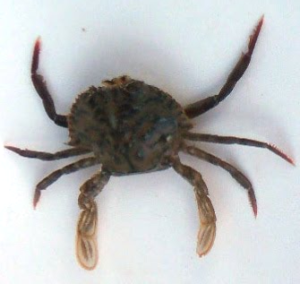 Eventually megalops settle and metamorphoses to the first crab stage which looks much like an adult crab, but is only 1/5 of an inch from point to point.
Eventually megalops settle and metamorphoses to the first crab stage which looks much like an adult crab, but is only 1/5 of an inch from point to point.
Now juveniles they are omnivorous and will eat both animal and vegetable substances, such as fish, shellfish, and aquatic plants.
It is important to avoid predators such as fish and other crabs.
They continue to molt, growing larger each time until reaching adult size (about 5¼ – 5½ in.) after 18-20 molts.
The amount of growth with each molt varies depending on water salinity, temperature, and other environmental factors.
They should reach harvestable size (4 1/2 in.) within one year.
